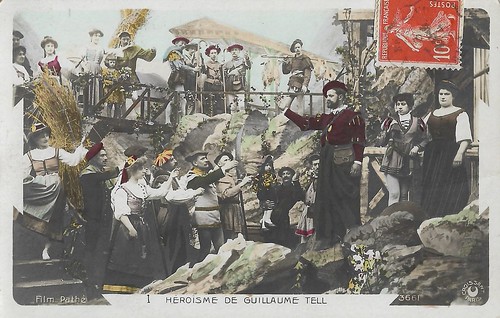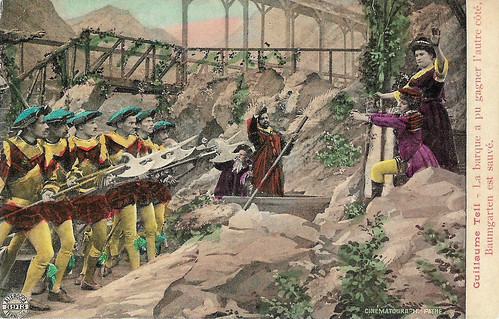
French postcard by Croissant, Paris, series 3661, no. 1. Photo: Film Pathé. Edmond Boutillon as Gessler in Guillaume Tell (Lucien Nonguet, 1903). Unknown is who played Tell. Caption: Héroïsme de Guillaume Tell. This exact image does not appear in the remaining print, as the acclamation in the end of the film takes place on a town square, while this setting refers to tableau 1, near the river.

French postcard by Croissant, Paris, series 3661, no. 2. Photo: Film Pathé. Edmond Boutillon as Gessler in Guillaume Tell (Lucien Nonguet, 1903). Caption: Le serment de Grutli. This card depicts the so-called Rütli-Schwur, the legendary oath taken at the foundation of the Old Swiss Confederacy.

French postcard by Croissant, Paris, series 3661, no. 3. Photo: Film Pathé. Edmond Boutillon as Gessler in Guillaume Tell (Lucien Nonguet, 1903). Caption: Switzerland cheers its liberator.
A drama in five tableaux
1. Heroïsme de Tell (William Tell's heroism): A mountainous landscape with a staircase. William Tell helps the peasant Baumgarten escape on a rowing boat just before a group of Gessler's soldiers arrives. The boat has reached the other shore, and Baumgarten is saved from the wrath of Gessler's soldiers.
2. La conjuration / Le sermon de Grutli (The Plot): A clearing near a mountain lake. A group of people enter and surrounds William Tell. The Swiss, led by Tell, take a holy oath against their suppressor.
3. La pomme (The Apple): A village square in the mountains. Several villagers enter the square, followed by two heralds who sound their trumpets before a proclamation is read: Everybody must salute the hat of Governor Gessler hanging on a pole. Everybody does it except William Tell, who has just entered with his son. As punishment, he must shoot with his bow an arrow at an apple placed on his son's head. He succeeds but is nevertheless arrested.
4. La mort de Gessler (Death of Gessler): An embankment in a mountainous landscape. Gessler arrives on a rowboat, and William Tell shoots an arrow, which kills Gessler.
5. La Suisse acclame Tell son liberateur (The Swiss cheer their Liberator): Swiss villagers are dancing on a square. William Tell appears and all cheer him.

Italian postcard, a reproduction of the original postcard by Ed. Alterocca, Terni, no. 3913, card 1 of 5. Photo: Cinématographes Pathé. Scene from Guillaume Tell / William Tell (Lucien Nonguet, 1903). Caption: The boat has reached the other shore, and Baumgarten is saved. (William Tell helps a peasant escape on a rowing boat just before a group of soldiers enters.)

French /Italian postcard, a reproduction of the original postcard by Ed. Alterocca, Terni, no. 3915, card 3 of 5. Photo: Cinématographes Pathé. Scene from Guillaume Tell / William Tell (Lucien Nonguet, 1903). Caption: Tell directs his arrow towards the apple placed on the head of his son. This card shows the most famous scene of the tale of William Tell.
Forced to shoot an apple on the head of his son
Guillaume Tell / William Tell (Lucien Nonguet, 1903) tells the historic legend of Swiss freedom fighter Wilhelm Tell, who is forced by the Habsburg ruler Gessler to shoot an apple from the head of his son. The film is shot in a tableau style, and follows the "single, unified viewpoint of the autonomous shot-scene". A Cinema History: "The film is mostly interesting as an example of an early cinematographic adaptation of a theatre play which is basically only filmed theatre in an abbreviated way and without any of the new possibilities offered by cinema."
It was the first try to make a cinematographic adaptation of William's Tell story as told by Friedrich Schiller in his 1804 drama. Although Georges Méliès directed Guillaume Tell et le clown/ Adventures of William Tell (1998), this was just a knockabout farce featuring a clown trying to shoot an apple off the head of a dummy, which comes to life.
The sets of Guillaume Tell / William Tell were designed by Vincent Lorant-Heilbronn. From the Pathé catalogue: "This popular and interesting legend takes place amidst the country life of the mountain population. The beautiful and picturesque sights which exist in Switzerland have given us an opportunity of utilising the resources our theatre affords, and our scene-painters have been able to have a free run on their imaginations and have completed the work by a series of magnificent scenes of the most artistic character."
Guillaume Tell / William Tell was not the first historical film that Lucien Nonguet directed for Pathé. He had already directed Épopée napoléonienne, also in 1903, one of Pathé's first historical films. The film is also known as The Life of Napoleon, Napoleon Bonaparte or The Rise and Fall of Napoleon the Great in the United States. Épopée napoléonienne came out in France in 1903 and in the US in 1904.
Some copies of Guillaume Tell / William Tell were colourised with the mechanical stencil-based film tinting process Pathécolor in the workshop of Segundo de Chomón in Barcelona. The film was distributed by Pathé Frères in 1903 in France and in 1904 in the United States. In the latter country, it was also distributed by the Kleine Optical Company, the Edison Manufacturing Company, and the Lubin Manufacturing Company.

French /Italian postcard, a reproduction of the original postcard by Ed. Alterocca, Terni, no. 3916, card 4 of 5. Photo: Cinématographes Pathé. Scene from Guillaume Tell / William Tell (Lucien Nonguet, 1903). Caption: Infuriated, Gessler commands to arrest Tell on the spot.

French /Italian postcard, a reproduction of the original postcard by Ed. Alterocca, Terni, no. 3917, card 5 of 5. Photo: Cinématographes Pathé. Scene from Guillaume Tell / William Tell (Lucien Nonguet, 1903). Caption: The death of Gessler. Switzerland cheers Tell as its liberator.

French postcard by Pathé frères. Edmond Boutillon as Gessler in Guillaume Tell (Lucien Nonguet, 1903). Caption: Théâtre Pathé Grolée, Lyon.
Sources: Fondation Jerome Seydoux Pathé (French), A Cinema History, Wikipedia (English) and IMDb. See also YouTube.
No comments:
Post a Comment